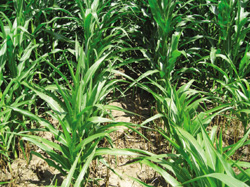
Features
Agronomy
Identity Preserved
Roundup Ready canola volunteers not a persistent problem
Good weed management practices key to success.
November 29, 2007 By Donna Fleury
With the majority of canola acreage in western Canada seeded to herbicide tolerant
canola varieties, there have been questions about the persistence of volunteers.
Roundup Ready canola varieties represent a large number of acres, and were selected
for a research study by Agriculture and Agri-Food Canada (AAFC). The research
results showed that Roundup Ready canola volunteers were not a persistent problem
if the volunteers were carefully managed in the first year following the canola
crop.
 |
| Pre-seed and in-crop volunteer canola control is critical to eliminating persistent problems. |
The research study began in October 2000 at seven sites in western Canada:
Beaverlodge, Lacombe and Lethbridge, Alberta; Saskatoon, Scott and Swift Current,
Saskatchewan; and Winnipeg, Manitoba. With the exception of Beaverlodge, canola
had not been grown at any of the sites for at least two years. To be able to
measure the canola volunteers, a known amount of Roundup Ready canola seed was
scattered on the plots in October 2000.
The plots were managed with a three year crop rotation of wheat-pea-barley,
or fallow-pea-fallow, using five different seeding systems with different seeding
dates and soil disturbance levels. The five seeding system combinations were
early, normal and late seeding in low disturbance direct seeding (LDS), and
high disturbance direct seeding (HDS) and conventional tillage (CT) at normal
seeding dates.
Volunteer canola plant density was measured four times each year, at pre-planting,
in-crop pre-spray, in-crop post-spray (three to four weeks after herbicide application)
and in the fall. Herbicides and/or tillage treatments were used to ensure that
volunteer canola plants detected in the plots were not allowed to produce seed.
Therefore, the results of the study deal strictly with the persistence of the
initial seed scattered on the soil surface in the fall of 2000. Under conditions
that growers experience, canola volunteer management would not be 100 percent
and some volunteers would produce new seed that would augment volunteer canola
seedbanks.
"The most significant finding from the study was that if the volunteers
were controlled at the pre-seed and in-crop intervals in the first year, then
there was little persistence of volunteers beyond that year," explains
Dr. Neil Harker, weed scientist at the Lacombe Research Centre. The pre-seed
application was done where required, with the in-crop application the most important.
"If growers are vigilant with their weed control in the year after Roundup
Ready canola is grown, especially at that in-crop interval, then they are going
to be able to manage the volunteers quite effectively." The differences
in seeding dates did not seem to make any significant difference in weed populations.
Averaged across all locations and seeding systems, total canola volunteers
before the crop was planted and before in-crop herbicide application were: 6.2,
0.7 and 0.0 plants per square metre for 2001, 2002 and 2003, respectively. "It
was only in the first year that the volunteer densities were high enough to
warrant herbicide application," says Harker. "Although there were
volunteer plants detected even after two years, they were in very small numbers
and were not a long-term problem."
Volunteer canola occurrence probabilities averaged across all seeding systems
and locations from 2001 to 2003. Data describe the average probability of finding
one or more canola volunteers in any of 20, 0.25 square metre random samples
in eight by 10 metre plots. Rotation systems are wheat-peas-barley (WPB) or
fallow-peas-fallow (FPF).
| Volunteer canola occurrence probabilities averaged across all seeding systems and locations from 2001 to 2003. Data describe the average probability of finding one or more canola volunteers in any of 20, 0.25 square metre random samples in 8m x 10m plots. Rotation systems are wheat-peas-barley (WPB) or fallow-peas-fallow (FPF). |
 |
Direct seeding provides best option
The other significant finding, which was contrary to some previous research,
showed that with a few exceptions, higher levels of soil disturbance led to
higher volunteer canola densities over time. Past research suggested that higher
volunteer canola densities were associated with reduced tillage. "From
the information we have now, it indicates that direct seeders have a better
system for managing volunteers than those that have more soil disturbance,"
says Harker.
"We were a little surprised at the results, but they support some recent
studies in both Saskatchewan and England that show if you leave canola seed
on the soil surface, then less secondary dormancy will develop," he explains.
That means the canola will not go into longer cycles of coming up later and
reducing its persistence. The studies concluded that to reduce secondary dormancy
in canola seed, it was particularly important to avoid tillage immediately after
harvest.
"Another research study from the University of Saskatchewan showed that
the tendency for secondary dormancy is very cultivar specific," says Harker.
Some cultivars are much more secondary dormancy prone than others. To-date,
varieties are not currently evaluated for this characteristic and breeding programs
have not been screening out this trait. "In the future, if we can start
labeling cultivars as being more secondary dormancy prone than others, then
this should be a factor in a grower's decision-making."
Managing Roundup Ready canola volunteers, and other weeds, includes the same
good weed management practices of well planned crop and herbicide rotations,
high seeding rates and early weed removal. "Diverse crop rotations are
the key to any weed management problem, and that is true for herbicide tolerant
canola volunteers as well," says Harker. "Combining these good management
practices with what our research shows about controlling volunteers in the first
year at pre-seed and in-crop intervals means Roundup Ready canola volunteers
shouldn't become a persistent problem."